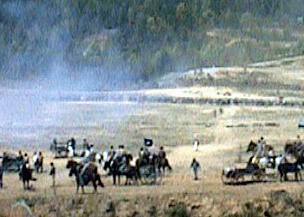Combat Results
 A common combat results calculation is used for both fire and melee
results. The combat results calculation is based on four parameters:
a combat value, a modifier, a Low Combat Value
(LCV) and a High Combat Value
(HCV). For fire combat, the combat value is the adjusted fire value
of the firing units. For melee combat, the combat value is the
adjusted strength of the opposing side. The given modifiers are
applied to the given combat value to arrive at the effective combat
value. The Low Combat Value and High Combat Value are the extreme
possible casualties resulting from a base-line combat value of 1000.
The effective combat value is used to scale these accordingly
resulting in low and high possible casualties. Finally a random
value is selected between the low and high casualty values to arrive
at the final combat result.
A common combat results calculation is used for both fire and melee
results. The combat results calculation is based on four parameters:
a combat value, a modifier, a Low Combat Value
(LCV) and a High Combat Value
(HCV). For fire combat, the combat value is the adjusted fire value
of the firing units. For melee combat, the combat value is the
adjusted strength of the opposing side. The given modifiers are
applied to the given combat value to arrive at the effective combat
value. The Low Combat Value and High Combat Value are the extreme
possible casualties resulting from a base-line combat value of 1000.
The effective combat value is used to scale these accordingly
resulting in low and high possible casualties. Finally a random
value is selected between the low and high casualty values to arrive
at the final combat result.
For example, given a combat value of 400, a modifier of 25%, a Low Combat Value of 5 and a High Combat Value of 25, the effective combat value would be 500 (= 400 + 25%). This would be ½ of the base-line combat value of 1000. Thus the low casualty value would be 2.5 (= 5 / 2) and the high casualty value would be 12.5 (= 25 / 2). The resulting casualty value would be randomly generated between 2.5 and 12.5 for this combat. Finally, based on the fractional part of the casualty value, it is randomly rounded up or down. For example, if the casualty value was calculated to be 3.7, then 30% of the time this is rounded down to 3 and 70% of the time is rounded up to 4.
Artillery losses resulting from enemy artillery and infantry fire is calculated on the basis of 1 gun = 25 men. Combat losses less than 25 men result in a probability of a 1 gun loss proportional to the value. Thus a combat loss of 5 men applied to an artillery unit would result in a probability of 5/25 = 20% that a one gun loss would occur.
Fatigue results are calculated as random values between the casualty value and 3 times the casualty value.
When Morale Checks are applicable, they are determined based on a probability using the given loss as:
loss / (loss + 25)
Thus a unit that takes a loss of 25 men has a 50% chance of requiring a morale check and a unit that takes a loss of 100 men has an 80% chance of requiring a morale check.
When the optional rule Alternative Calculation of combat results is chosen for fire or melee results, then the resulting casualty value is based on the average of two default casualty calculations. This produces values which are more likely to be in the midrange of the casualty interval rather than uniformly distributed.
